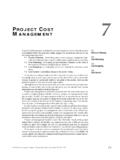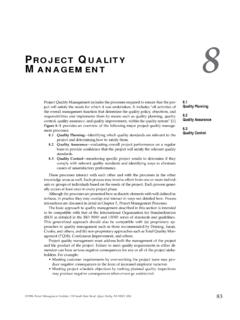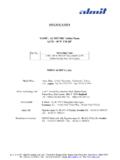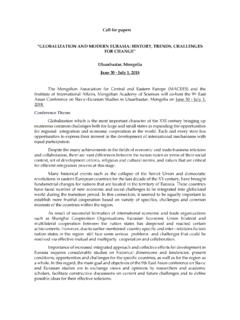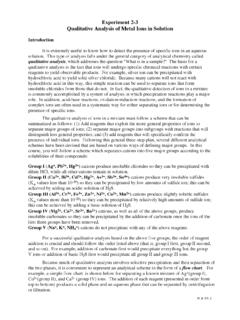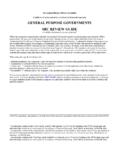Transcription of ROJECT QUALITY ANAGEMENT - …
1 1996 Project Management Institute, 130 South State Road, Upper Darby, PA 19082 USA83 Project QUALITY Management includes the processes required to ensure that the pro-ject will satisfy the needs for which it was undertaken. It includes all activities ofthe overall management function that determine the QUALITY policy, objectives, andresponsibilities and implements them by means such as QUALITY planning, qualitycontrol, QUALITY assurance, and QUALITY improvement, within the QUALITY system [1].Figure 8 1provides an overview of the following major project QUALITY manage-ment QUALITY Planning identifying which QUALITY standards are relevant to theproject and determining how to satisfy QUALITY Assurance evaluating overall project performance on a regularbasis to provide confidence that the project will satisfy the relevant QUALITY Control monitoring specific project results to determine if theycomply with relevant QUALITY standards and identifying ways to eliminatecauses of unsatisfactory processes interact with each other and with the processes in the
2 Otherknowledge areas as well. Each process may involve effort from one or more individ-uals or groups of individuals based on the needs of the project. Each process gener-ally occurs at least once in every project the processes are presented here as discrete elements with well-defined in-terfaces, in practice they may overlap and interact in ways not detailed here. Processinteractions are discussed in detail in Chapter 3, Project Management basic approach to QUALITY management described in this section is intendedto be compatible with that of the International Organization for Standardization(ISO) as detailed in the ISO 9000 and 10000 series of standards and generalized approach should also be compatible with (a) proprietary ap-proaches to QUALITY management such as those recommended by Deming, Juran,Crosby, and others, and (b) non-proprietary approaches such as Total QUALITY Man-agement (TQM)
3 , Continuous Improvement, and QUALITY management must address both the management of the projectand the product of the project. Failure to meet QUALITY requirements in either di-mension can have serious negative consequences for any or all of the project stake-holders. For example: Meeting customer requirements by overworking the project team may pro-duce negative consequences in the form of increased employee turnover. Meeting project schedule objectives by rushing planned QUALITY inspectionsmay produce negative consequences when errors go Control84 1996 Project Management Institute, 130 South State Road, Upper Darby, PA 19082 USAFIGURE8 1A GUIDE TO THEPROJECTMANAGEMENTBODY OFKNOWLEDGEQ uality is the totality of characteristics of an entity that bear on its ability to sat-isfy stated or implied needs [2].
4 A critical aspect of QUALITY management in the pro-ject context is the necessity to turn implied needs into stated needs through projectscope management, which is described in Chapter project management team must be careful not to confuse qualitywith is a category or rank given to entities having the same functional use but dif-ferent requirements for QUALITY [3]. Low QUALITY is always a problem; low grade maynot be. For example, a software product may be of high QUALITY (no obvious bugs,readable manual) and low grade (a limited number of features), or of low QUALITY (many bugs, poorly organized user documentation) and high grade (numerous fea-tures).
5 Determining and delivering the required levels of both QUALITY and grade arethe responsibilities of the project manager and the project management project management team should also be aware that modern QUALITY man-agement complements modern project management. For example, both disciplinesrecognize the importance of: Customer satisfaction understanding, managing, and influencing needs sothat customer expectations are met or exceeded. This requires a combinationof conformance to specifications(the project must produce what it said itwould produce) and fitness for use(the product or service produced must sat-isfy real needs).
6 Prevention over inspection the cost of avoiding mistakes is always much lessthan the cost of correcting Tools and Work QUALITY management Operational Control Pareto Statistical Trend QUALITY Acceptance Completed Process Tools and QUALITY Scope Product Standards and Other process Benefit/cost Design of QUALITY management Operational Inputs to other Tools and QUALITY management Results of QUALITY Operational QUALITY planning tools QUALITY QUALITY QualityManagementFigure 8 QUALITY Management 1996 Project Management Institute, 130 South State Road, Upper Darby, PA 19082 USA85 Management responsibility success requires the participationof all membersof the team, but it remains the responsibilityof management to provide theresources needed to succeed.
7 Processes within phases the repeated plan-do-check-act cycle described byDeming and others is highly similar to the combination of phases and process-es discussed in Chapter 3, Project Management addition, QUALITY improvement initiatives undertaken by the performing orga-nization ( , TQM, Continuous Improvement, and others) can improve the qual-ity of the project management as well as the QUALITY of the project , there is an important difference that the project management teammust be acutely aware of the temporary nature of the project means that invest-ments in product QUALITY improvement, especially defect prevention and appraisal,must often be borne by the performing organization since the project may not lastlong enough to reap the QUALITYPLANNINGQ uality planning involves identifying which QUALITY standards are relevant to theproject and determining how to satisfy them.
8 It is one of the key facilitating process-es during project planning (see Section , Planning Processes) and should beperformed regularly and in parallel with the other project planning processes. Forexample, the desired management QUALITY may require cost or schedule adjustments,or the desired product QUALITY may require a detailed risk analysis of an identifiedproblem. Prior to development of the ISO 9000 Series, the activities described hereas QUALITY planningwere widely discussed as part of QUALITY QUALITY planning techniques discussed here are those used most frequentlyon projects.
9 There are many others that may be useful on certain projects or insome application project team should also be aware of one of the fundamental tenets of mod-ern QUALITY management QUALITY is planned in, not inspected Inputs to QUALITY QUALITY policy. QUALITY policy is the overall intentions and direction of an organi-zation with regard to QUALITY , as formally expressed by top management [4]. Thequality policy of the performing organization can often be adopted as is for use bythe project. However, if the performing organization lacks a formal QUALITY policy, orif the project involves multiple performing organizations (as with a joint venture),the project management team will need to develop a QUALITY policy for the of the origin of the QUALITY policy, the project management team isresponsible for ensuring that the project stakeholders are fully aware of it ( ,through appropriate information distribution, as described in Section ).
10 InputsTools & QUALITY Scope Product Standards Other process Benefit/cost Design of QUALITY Operational Inputs to 1996 Project Management Institute, 130 South State Road, Upper Darby, PA 19082 USAFIGURE8 2A GUIDE TO THEPROJECTMANAGEMENTBODY Scope statement. The scope statement (described in Section ) is a key input toquality planning since it documents major project deliverables as well as the projectobjectives which serve to define important stakeholder Product description. Although elements of the product description (described inSection ) may be embodied in the scope statement, the product descriptionwill often contain details of technical issues and other concerns that may affect qual-ity Standards and regulations.
